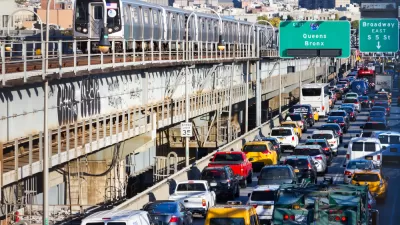Instead of removing urban freeways, which have proven to be destructive to communities and economies—in some cases deliberately so—many cities are expanding freeways in and around cities.

The New York Times recently published an interactive opinion piece that provides visual evidence of the mark left by freeways and highways on dense urban communities with maps and historic aerial photography superimposed with contemporary images.
The article was written by Adam Paul Susaneck, who might be more familiar to some readers as the founder of the Segregation by Design, a blog and Instagram account dedicated to documenting the destruction of transportation planning and housing and land use policy on communities of color in the United States.
“Through a series of stark aerial before-and-after comparisons, figure-ground diagrams, and demographic data, this project will reveal the extent to which the American city was methodically hollowed out based on race. The project will cover the roughly 180 municipalities which received federal funding from the 1956 Federal Highway Act, which created the interstate highway system,” according to the Blog’s about page.
The New York Times article deploys that methodology in the article, first by focusing on the North Houston Highway Improvement Project, a project underway by the Texas Department of Transportation to widen Interstate 45 near downtown Houston, displacing an estimated 1,000 households and multiple other businesses and cultural resources in the process. Susaneck cites the project of an example of the same destructive planning practices of the 1960s at work in the 2020s.
“Rather than being a rare exception, projects like this one fit a longstanding pattern of how the United States chooses to force highways through communities with the least political power to resist. A Los Angeles Times analysis found that expansions of existing highways have displaced more than 200,000 people over the past three decades, predominantly in nonwhite neighborhoods,” writes Susaneck.
Other examples of car-centric planning and discriminatory housing practices gutting urban communities include the Cross Bronx Expressway, famously championed by Robert Moses, restrictive covenants in Minneapolis, and urban renewal in Chicago.
“The urban highway network and the urban renewal projects it spawned are tools of systemic discrimination. They’re also in terrible shape: The American Society of Civil Engineers gives the overall condition of America’s roads a D grade. As many of the highways built in the 1950s and ’60s reach the end of their useful life, now is the perfect opportunity to radically rethink the urban environment that shapes social relations within American city life,” writes Susaneck.
FULL STORY: Mr. Biden, Tear Down This Highway

Alabama: Trump Terminates Settlements for Black Communities Harmed By Raw Sewage
Trump deemed the landmark civil rights agreement “illegal DEI and environmental justice policy.”

Planetizen Federal Action Tracker
A weekly monitor of how Trump’s orders and actions are impacting planners and planning in America.

The 120 Year Old Tiny Home Villages That Sheltered San Francisco’s Earthquake Refugees
More than a century ago, San Francisco mobilized to house thousands of residents displaced by the 1906 earthquake. Could their strategy offer a model for the present?

In Both Crashes and Crime, Public Transportation is Far Safer than Driving
Contrary to popular assumptions, public transportation has far lower crash and crime rates than automobile travel. For safer communities, improve and encourage transit travel.

Report: Zoning Reforms Should Complement Nashville’s Ambitious Transit Plan
Without reform, restrictive zoning codes will limit the impact of the city’s planned transit expansion and could exclude some of the residents who depend on transit the most.

Judge Orders Release of Frozen IRA, IIJA Funding
The decision is a victory for environmental groups who charged that freezing funds for critical infrastructure and disaster response programs caused “real and irreparable harm” to communities.
Urban Design for Planners 1: Software Tools
This six-course series explores essential urban design concepts using open source software and equips planners with the tools they need to participate fully in the urban design process.
Planning for Universal Design
Learn the tools for implementing Universal Design in planning regulations.
Clanton & Associates, Inc.
Jessamine County Fiscal Court
Institute for Housing and Urban Development Studies (IHS)
City of Grandview
Harvard GSD Executive Education
Toledo-Lucas County Plan Commissions
Salt Lake City
NYU Wagner Graduate School of Public Service





























